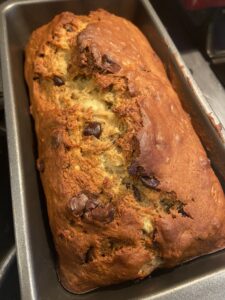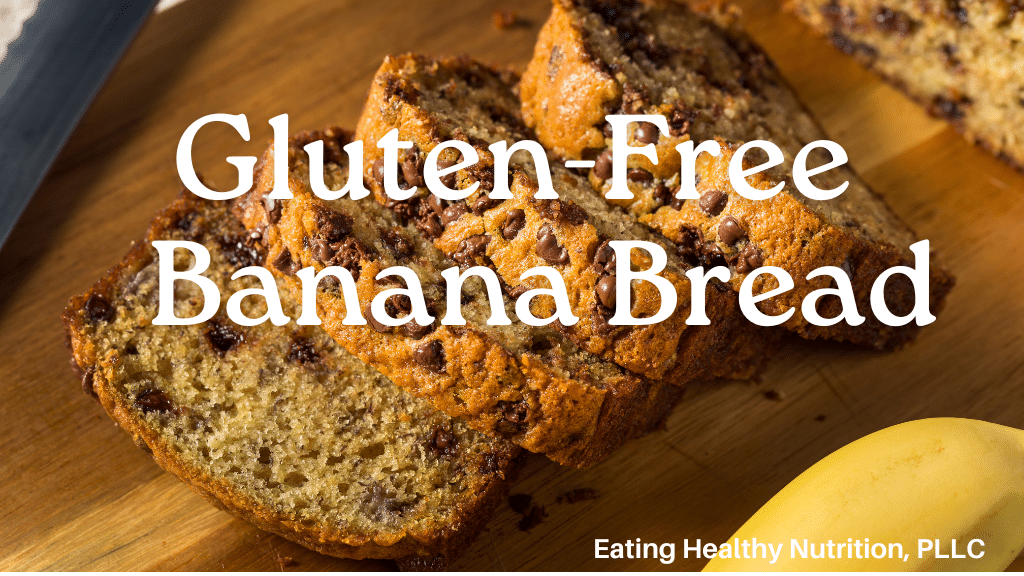I currently have three overly ripe bananas sitting on my counter, which is probably what sparked this whole idea. Instead of letting them go to waste, I decided it was time to bake a fresh loaf of gluten-free banana bread and to finally share my take on it here.
There’s something about banana bread that feels timeless. Almost every family I know has their own unique recipe that they remember making as a child. Over the years, I’ve tested plenty of versions with and without gluten, with and without eggs, with and without dairy. The list goes on and on. The good news is, with the right ingredients and a few smart swaps, gluten-free banana bread can taste every bit as soft, moist, and flavorful as traditional banana bread.
As a registered dietitian (and someone who’s baked her share of trial-and-error loaves), I love showing that gluten-free baking doesn’t have to be complicated. Whether you’re planning to make your own or buy one that’s already done for you, there are great options out there and I’ll walk you through both.
What Makes a Great Gluten-Free Banana Bread
Gluten-free banana bread can be tricky because gluten is what gives baked goods their structure and chew. Without it, the wrong flour blend can leave your loaf dense or crumbly. The secret is balance. The right flour combination, enough moisture, and the perfect level of sweetness. I don’t know about you, but traditional banana breads have way too much sugar for me.
Bananas do most of the work here. They naturally add moisture, sweetness, and fiber. Combine that with a well-rounded flour blend and a solid binder, and you’ve got the perfect ingredients to make a great gluten-free loaf.
Store-Bought Gluten-Free Banana Bread Brands Worth Trying
If you’re not in the mood to bake (or your bananas aren’t quite ripe enough), there are a few store-bought gluten-free banana breads that are surprisingly good. While homemade will always win on freshness, these brands make solid options when you need something quick, consistent, and safe for a gluten-free household.
- Simple Mills
Simple Mills is known for clean, short ingredient lists, and their banana bread mix delivers on both taste and texture. It’s made with almond flour, coconut flour, and flaxseed, so it’s higher in healthy fats and fiber than most versions. The flavor leans more “banana muffin” than dense loaf, but it’s soft and subtly sweet. - King Arthur Baking Company
King Arthur’s Gluten-Free Banana Bread Mix is one of the most consistent store-bought mixes out there. It bakes up moist and tender, with that golden crust you want in a classic banana bread. I appreciate that King Arthur’s products are certified gluten-free and easy to find in most grocery stores or online. - Banana Manna
Banana Manna offers a line of gluten-free loaves that are moist, rich, and full of real banana flavor. Their gluten-free banana bread is made with simple ingredients. You can order directly from their website and they ship nationwide. - Local Gluten-Free Bakeries
Don’t overlook your local bakeries. Many small gluten-free or allergy-friendly bakeries make fresh banana bread that rivals (or beats) anything you’ll find packaged. If you’re in doubt, ask whether they bake in a dedicated gluten-free kitchen.
The Dietitian’s Tips for Making Moist and Flavorful Gluten-Free Banana Bread at Home
Gluten-free baking is both a science and an art. When it works, it’s magic… soft, flavorful, and perfectly tender. When it doesn’t, well, you’re left with something that crumbles like sand. Over time, I’ve learned a few tricks that make all the difference when baking banana bread without gluten.
- Use a blend of gluten-free flours.
A single gluten-free flour rarely gives that perfect texture. The best results usually come from a mix, like brown rice flour, oat flour, and tapioca starch. A good all-purpose gluten-free flour blend will save time and guesswork (I use Cup4Cup because it is processed in a facility that is top 9 allergen-free and gluten-free). - Don’t skip the binder.
Gluten gives structure to traditional banana bread, so without it, you need a binder. Eggs do the job beautifully, or you can use flaxseed or chia seeds mixed with water for a vegan version. They help hold everything together and add a bit of moisture and needed fat. - Ripe bananas are non-negotiable.
The darker the peel, the better the flavor. Overripe bananas bring natural sweetness and soft texture. If yours aren’t quite there yet, bake them (peel on) at 300°F for about 15 minutes to soften and sweeten. Our recipe calls for 3 overripe bananas. This is the perfect amount of sweet banana flavor and moisture. - Balance your moisture.
Gluten-free flours tend to absorb more liquid, so you may need slightly more oil, butter, or applesauce than a traditional recipe calls for. If your batter feels thick like cookie dough, add a tablespoon or two of milk or water to loosen it. - Rest your batter before baking.
Letting your batter sit for 10–15 minutes before putting it in the oven gives the flours time to hydrate, resulting in a softer crumb and a smoother texture. It’s an easy step that really pays off. I’ve also found that letting your batter rest actually enhances the flavor and helps mellow out that distinct taste gluten-free flours can have. - Don’t over bake.
Check your bread at the 45-minute mark. Gluten-free loaves can dry out fast. A toothpick should come out mostly clean with a few moist crumbs. Once it’s cool, wrap it tightly to keep it soft for days.
My Go-To Gluten-Free Banana Bread Recipe
Now that you know what makes a delicious gluten-free banana bread, it’s time to put those ripe bananas to good use. Below is my go-to recipe. Feel free to adapt it to your preferences or swap in your favorite allergy-friendly ingredients.
Ingredients
- 3 ripe bananas, mashed
- 1/3 cup melted butter or neutral oil (like avocado, canola, or light olive oil)
- 1/2 cup brown sugar
- 1 large egg (or 1 flax egg if egg-free: 1 tbsp flaxseed + 3 tbsp water)
- 1 teaspoon vanilla extract
- 1 teaspoon baking soda
- 1/2 teaspoon salt
- 1 1/2 cups 1:1 gluten-free flour
- Optional: 1/2 cup allergy-safe chocolate chips (Enjoy Life or your preferred brand)
Directions
- Preheat the oven to 350°F. Grease or line a loaf pan with parchment paper.
- In a large bowl, mash bananas until smooth.
- Whisk in melted butter (or oil), sugar, egg, and vanilla until combined.
- In a medium size bowl, whisk flour, baking soda and salt.
- Add dry ingredients to wet ingredients. Mix just until no dry spots remain. Don’t overmix.
- Fold in chocolate chips.
- Pour batter into the prepared pan.
- Bake for 45 minutes or until a toothpick inserted in the center comes out clean.
- Cool in the pan for 10 minutes, then transfer to a rack.

If you love cozy gluten-free baking, you’ll love this too! I’ve put together my Top 9 Allergen-Free & Gluten-Free Holiday Desserts to make your next gathering a little easier (and safer).
Download it free here and get instant access to allergy-friendly dessert recipes that everyone can enjoy, even those without allergies.
Looking for a No-Sugar-Added Banana Bread Option?
If you’re looking for something a little different or want to try a version that’s naturally sweetened, nutrient-dense and a healthy breakfast option. Try my Breakfast Banana Bread from The Allergy-Friendly Cookbook. It might be your next favorite. It’s made with avocado for healthy fats and extra moisture and contains zero added sugar, yet it still manages to taste rich and satisfying. Those overripe bananas make all the difference.
You can find the full recipe in my cookbook here!
How to Store and Freeze Gluten-Free Banana Bread
One of the best parts about banana bread is how well it keeps. A freshly baked loaf rarely lasts long in my house, but when it does, storing it properly makes all the difference in keeping it soft and flavorful.
At Room Temperature:
Once your loaf has completely cooled, wrap it tightly in plastic wrap or foil and store it in an airtight container. It will stay fresh for up to three days at room temperature. Avoid refrigerating unless your kitchen runs warm. The fridge can dry it out.
In the Freezer:
For longer storage, slice the banana bread before freezing. Wrap each slice in plastic wrap or parchment, then place them all in a freezer-safe bag. This makes it easy to grab one slice at a time. Frozen banana bread keeps well for up to three months.
Reheating Tips:
To enjoy a slice that tastes freshly baked, reheat it in the microwave for about 15–20 seconds or warm it in a toaster oven for a few minutes. It brings back that soft, just-out-of-the-oven texture.
Creative Ways to Enjoy Gluten-Free Banana Bread
Banana bread is great on its own, but it’s even better when you get creative. Here are a few of my favorite ways to turn a simple slice into something special:
- Make banana bread French toast. Dip slices in whisked eggs and milk, then cook on a griddle for a warm, indulgent breakfast.
- Top with almond or sunflower seed butter. Adds protein and healthy fats while keeping you full longer. This is my go-to breakfast after making my Breakfast Banana Bread.
- Layer it into yogurt parfaits. Crumble slices with yogurt and fruit for a quick dessert or snack.
- Serve it toasted with honey or cinnamon butter. A simple way to refresh a day-old loaf.
Final Thoughts from a Dietitian (and Banana Bread Fan)
Gluten-free baking can feel intimidating at first, but once you understand what makes these recipes work, it’s surprisingly simple. Banana bread is one of those timeless recipes that brings people together, whether it’s for a weekend breakfast, an afternoon snack, or a quick bite before heading out the door.
If you’ve been on the hunt for a gluten-free banana bread that tastes like the “real thing,” I hope this gives you the confidence to try (or buy) one that makes you forget it’s gluten-free in the first place.
